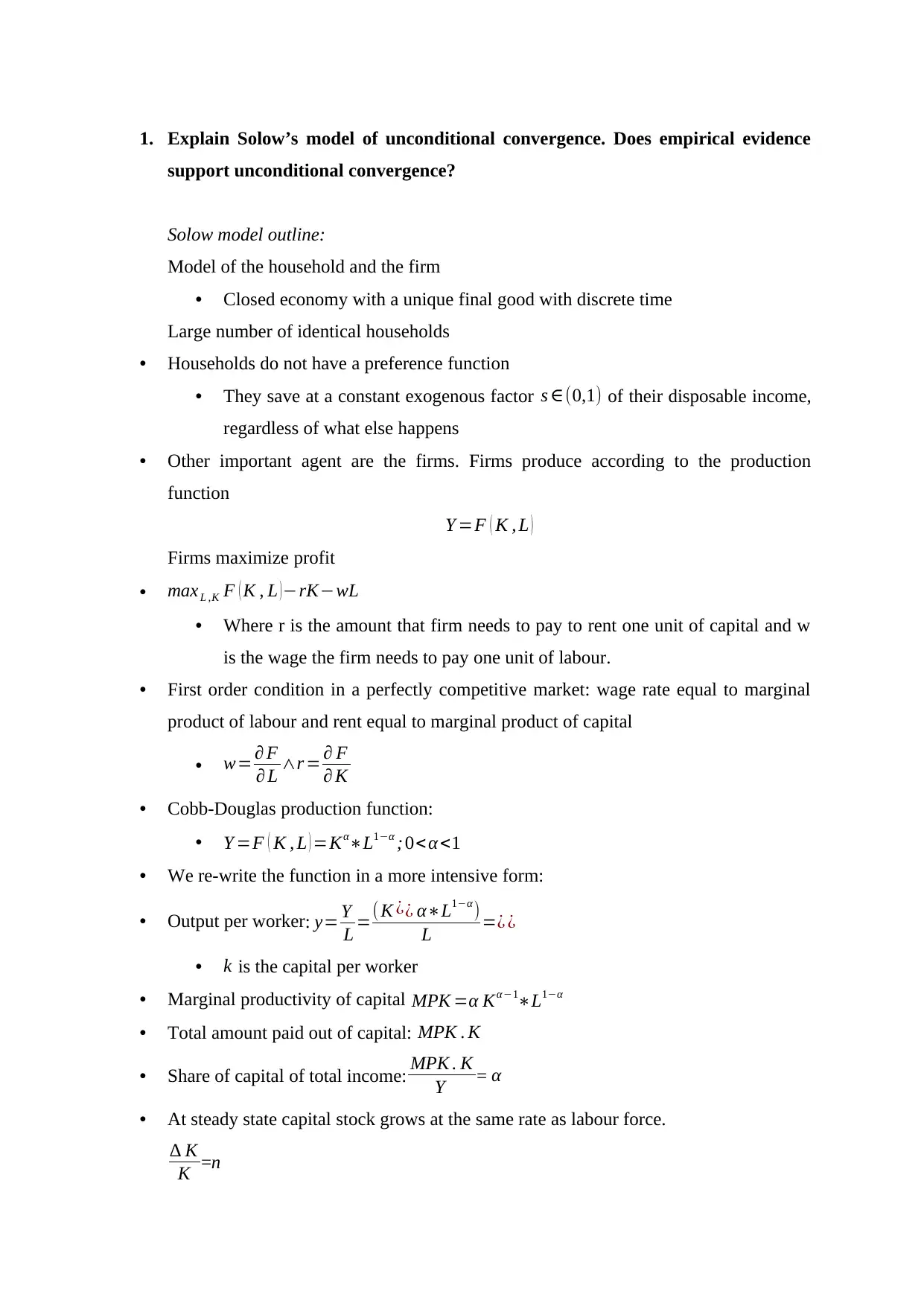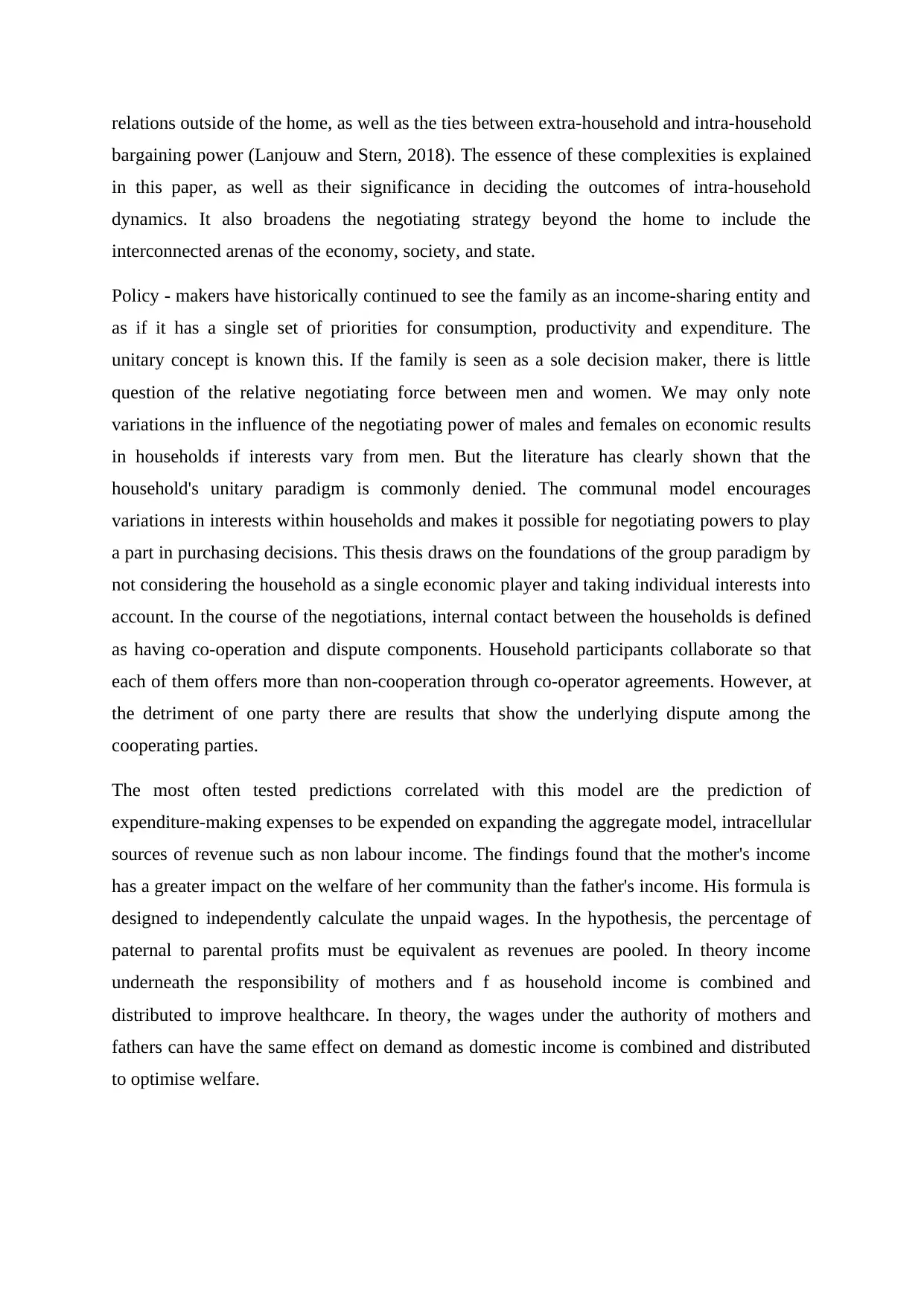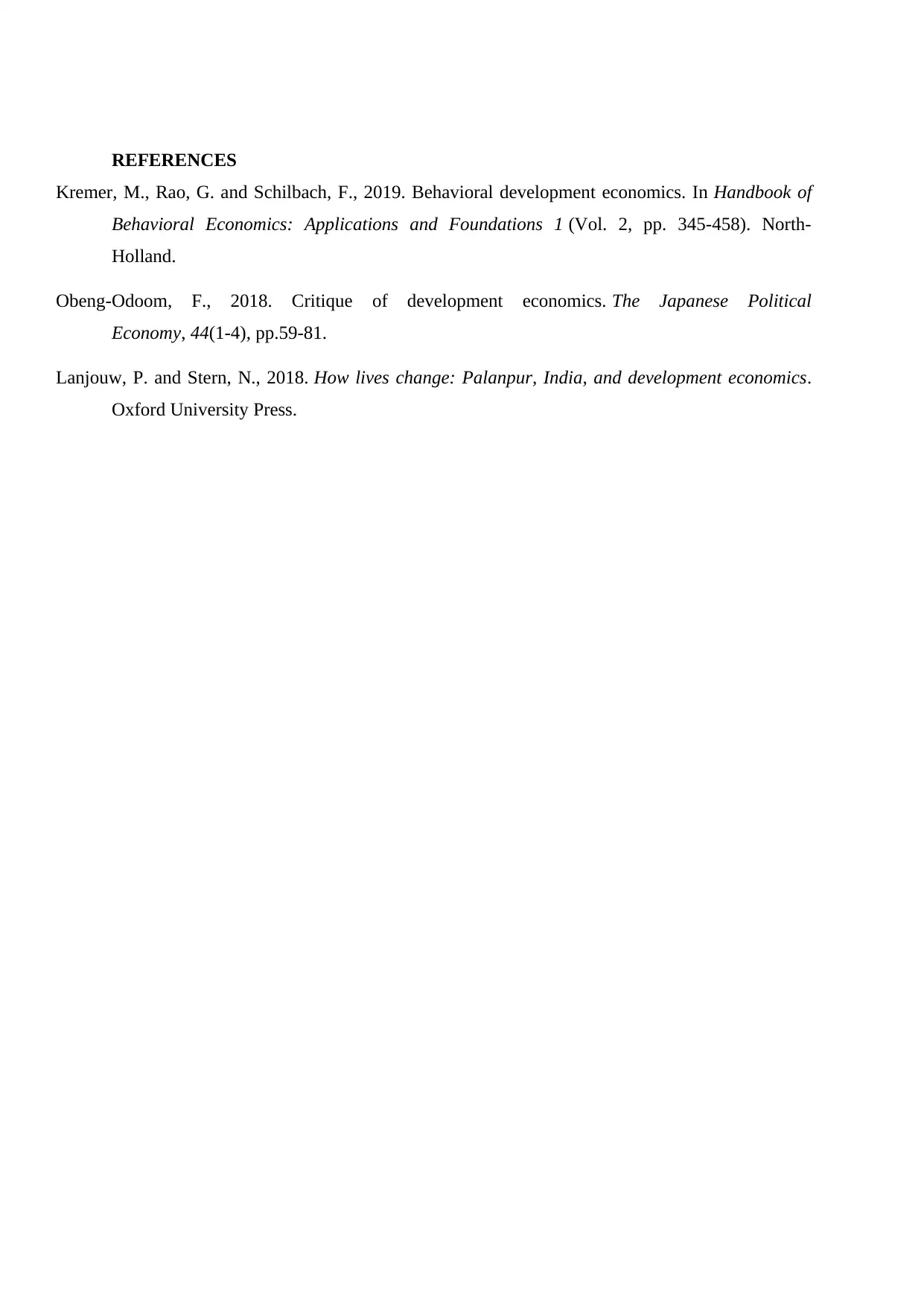Development Economics: Convergence, Household Models, and Biases
VerifiedAdded on 2022/12/15
|7
|1645
|88
Homework Assignment
AI Summary
This assignment delves into two key areas of development economics. The first part explains Solow's model of unconditional convergence, discussing its implications and empirical support, while also addressing its limitations. The second part focuses on Sen's "Cooperative-Conflict" model of the household, examining its tenets and the impact of 'perceived biases' on women's bargaining position within the family. It explores how factors like savings rates, technological change, and population growth influence economic outcomes, and how gender dynamics affect household decision-making and resource allocation. The assignment draws on the foundations of the group paradigm by not considering the household as a single economic player and taking individual interests into account.

Development economics
Paraphrase This Document
Need a fresh take? Get an instant paraphrase of this document with our AI Paraphraser

Contents
1. Explain Solow’s model of unconditional convergence. Does empirical evidence
support unconditional convergence?......................................................................................3
2. What are the basic tenets of Sen’s “Cooperative-Conflict” model of the household?
How do ‘perceived biases’ affect women’s bargaining position in the family?....................4
1. Explain Solow’s model of unconditional convergence. Does empirical evidence
support unconditional convergence?......................................................................................3
2. What are the basic tenets of Sen’s “Cooperative-Conflict” model of the household?
How do ‘perceived biases’ affect women’s bargaining position in the family?....................4

1. Explain Solow’s model of unconditional convergence. Does empirical evidence
support unconditional convergence?
Solow model outline:
Model of the household and the firm
• Closed economy with a unique final good with discrete time
Large number of identical households
• Households do not have a preference function
• They save at a constant exogenous factor s ∈(0,1) of their disposable income,
regardless of what else happens
• Other important agent are the firms. Firms produce according to the production
function
Y =F ( K , L )
Firms maximize profit
• maxL ,K F ( K , L ) −rK−wL
• Where r is the amount that firm needs to pay to rent one unit of capital and w
is the wage the firm needs to pay one unit of labour.
• First order condition in a perfectly competitive market: wage rate equal to marginal
product of labour and rent equal to marginal product of capital
• w= ∂ F
∂ L ∧r = ∂ F
∂ K
• Cobb-Douglas production function:
• Y =F ( K , L ) =Kα∗L1−α ; 0<α<1
• We re-write the function in a more intensive form:
• Output per worker : y= Y
L =( K ¿¿ α∗L1−α)
L =¿ ¿
• k is the capital per worker
• Marginal productivity of capital MPK =α Kα−1∗L1−α
• Total amount paid out of capital: MPK . K
• Share of capital of total income: MPK . K
Y = α
• At steady state capital stock grows at the same rate as labour force.
∆ K
K =n
support unconditional convergence?
Solow model outline:
Model of the household and the firm
• Closed economy with a unique final good with discrete time
Large number of identical households
• Households do not have a preference function
• They save at a constant exogenous factor s ∈(0,1) of their disposable income,
regardless of what else happens
• Other important agent are the firms. Firms produce according to the production
function
Y =F ( K , L )
Firms maximize profit
• maxL ,K F ( K , L ) −rK−wL
• Where r is the amount that firm needs to pay to rent one unit of capital and w
is the wage the firm needs to pay one unit of labour.
• First order condition in a perfectly competitive market: wage rate equal to marginal
product of labour and rent equal to marginal product of capital
• w= ∂ F
∂ L ∧r = ∂ F
∂ K
• Cobb-Douglas production function:
• Y =F ( K , L ) =Kα∗L1−α ; 0<α<1
• We re-write the function in a more intensive form:
• Output per worker : y= Y
L =( K ¿¿ α∗L1−α)
L =¿ ¿
• k is the capital per worker
• Marginal productivity of capital MPK =α Kα−1∗L1−α
• Total amount paid out of capital: MPK . K
• Share of capital of total income: MPK . K
Y = α
• At steady state capital stock grows at the same rate as labour force.
∆ K
K =n
⊘ This is a preview!⊘
Do you want full access?
Subscribe today to unlock all pages.

Trusted by 1+ million students worldwide

• This implies
n=s . APK −δ
Or, K
Y = s
n+δ
• Implications:
• Output per capita is constant in steady state
• The output per capita in the steady state is higher, the higher is the savings rate
and the lower are the labour force growth rate and depreciation
• Solow’s fundamental equation of motion:
∆ k=sf ( k ) − ( δ+n ) k
• ∆ k is the extent to which investment is adding to the capital term per worker
• sf ( k )− ( δ+n ) k is the amount of investment needed to offset depreciation and
equip the additional labour force.
Implications:
• Countries that have higher savings/ investment rates tend to be richer, all other things
being equal
• Countries with high population growth will tend to be poorer Solow model fails to
predict sustained per capita income growth.
• Economies may grow for a while, but not in the long run.
• Not originally developed to explain per capita income across countries
Unconditional convergence:
The Solow Model predicts that, regardless of their initial capital stock, two economies
with the same relative technological development, savings, population growth, and
depreciation will end up in the same steady state in the long run (Kremer and
Schilbach, 2019). A country with a lower initial capital stock will expand more
quickly, but will eventually reach the same steady state. It makes no difference where
they start (in terms of initial capital or income).
- In terms of empirical evidence, unconditional convergence will be a very strong
finding because in practise, savings, technological change, and other factors are
unlikely to be the same across countries.
- Baumol (1986) supported the unconditional convergence thesis for Japan, Finland,
Sweden, the United Kingdom, the United States, and Australia.
n=s . APK −δ
Or, K
Y = s
n+δ
• Implications:
• Output per capita is constant in steady state
• The output per capita in the steady state is higher, the higher is the savings rate
and the lower are the labour force growth rate and depreciation
• Solow’s fundamental equation of motion:
∆ k=sf ( k ) − ( δ+n ) k
• ∆ k is the extent to which investment is adding to the capital term per worker
• sf ( k )− ( δ+n ) k is the amount of investment needed to offset depreciation and
equip the additional labour force.
Implications:
• Countries that have higher savings/ investment rates tend to be richer, all other things
being equal
• Countries with high population growth will tend to be poorer Solow model fails to
predict sustained per capita income growth.
• Economies may grow for a while, but not in the long run.
• Not originally developed to explain per capita income across countries
Unconditional convergence:
The Solow Model predicts that, regardless of their initial capital stock, two economies
with the same relative technological development, savings, population growth, and
depreciation will end up in the same steady state in the long run (Kremer and
Schilbach, 2019). A country with a lower initial capital stock will expand more
quickly, but will eventually reach the same steady state. It makes no difference where
they start (in terms of initial capital or income).
- In terms of empirical evidence, unconditional convergence will be a very strong
finding because in practise, savings, technological change, and other factors are
unlikely to be the same across countries.
- Baumol (1986) supported the unconditional convergence thesis for Japan, Finland,
Sweden, the United Kingdom, the United States, and Australia.
Paraphrase This Document
Need a fresh take? Get an instant paraphrase of this document with our AI Paraphraser

- Since Baumol only included countries that were wealthy in 1979, there is a sample
selection bias.
- As a result, Japan was included but Argentina and Chile were not, despite the fact that
they were both middle-income countries in 1870.
- De Long, 1988: this was corrected by adding seven additional countries to Baumol's
records (Argentina, Chile, East Germany, Ireland, New Zealand, Portugal and Spain).
- As a result, convergence is less visible.
- Between 1870 and 1990, countries experienced dramatically different rates of
economic growth, according to Pritchett (1997).
The problem with UC is that it assumes that all countries will experience the same rate of
savings, economy, depreciation, and technological change (Obeng-Odoom, 2018). If this isn't
the case, convergence will not be possible. Assume that information spreads freely between
countries, resulting in the same technologies across all countries, but that other parameters
(such as savings and population growth rates) differ. Savings and other factors have no
impact on the amount of per capita income in Solow. Growth is solely dictated by relative
technological advancement. We should expect convergence in growth rates in the long run,
given that relative technological progress is presumed to be the same across countries.
2. What are the basic tenets of Sen’s “Cooperative-Conflict” model of the
household? How do ‘perceived biases’ affect women’s bargaining position in the
family?
A variety of economists have suggested alternative models in recent years, highlighting the
problems with a "unitary" conceptualization of the household. These models, particularly
those that incorporate the bargaining approach, provide a useful framework for examining
gender relations and shedding light on how gender inequalities are created and contested.
Simultaneously, the models have given insufficient or no attention to some crucial aspects of
intra-household gender dynamics, such as: What factors (particularly qualitative ones) affect
bargaining power? What position do social expectations and attitudes play in the negotiation
process, and how can these considerations be bargained for? What position do social
expectations and attitudes play in the negotiation process, and how can these considerations
be negotiated over? Is self-interest less motivating for women than it is for men, and how
could this affect bargaining outcomes? Most bargaining discussions often ignore gender
selection bias.
- As a result, Japan was included but Argentina and Chile were not, despite the fact that
they were both middle-income countries in 1870.
- De Long, 1988: this was corrected by adding seven additional countries to Baumol's
records (Argentina, Chile, East Germany, Ireland, New Zealand, Portugal and Spain).
- As a result, convergence is less visible.
- Between 1870 and 1990, countries experienced dramatically different rates of
economic growth, according to Pritchett (1997).
The problem with UC is that it assumes that all countries will experience the same rate of
savings, economy, depreciation, and technological change (Obeng-Odoom, 2018). If this isn't
the case, convergence will not be possible. Assume that information spreads freely between
countries, resulting in the same technologies across all countries, but that other parameters
(such as savings and population growth rates) differ. Savings and other factors have no
impact on the amount of per capita income in Solow. Growth is solely dictated by relative
technological advancement. We should expect convergence in growth rates in the long run,
given that relative technological progress is presumed to be the same across countries.
2. What are the basic tenets of Sen’s “Cooperative-Conflict” model of the
household? How do ‘perceived biases’ affect women’s bargaining position in the
family?
A variety of economists have suggested alternative models in recent years, highlighting the
problems with a "unitary" conceptualization of the household. These models, particularly
those that incorporate the bargaining approach, provide a useful framework for examining
gender relations and shedding light on how gender inequalities are created and contested.
Simultaneously, the models have given insufficient or no attention to some crucial aspects of
intra-household gender dynamics, such as: What factors (particularly qualitative ones) affect
bargaining power? What position do social expectations and attitudes play in the negotiation
process, and how can these considerations be bargained for? What position do social
expectations and attitudes play in the negotiation process, and how can these considerations
be negotiated over? Is self-interest less motivating for women than it is for men, and how
could this affect bargaining outcomes? Most bargaining discussions often ignore gender

relations outside of the home, as well as the ties between extra-household and intra-household
bargaining power (Lanjouw and Stern, 2018). The essence of these complexities is explained
in this paper, as well as their significance in deciding the outcomes of intra-household
dynamics. It also broadens the negotiating strategy beyond the home to include the
interconnected arenas of the economy, society, and state.
Policy - makers have historically continued to see the family as an income-sharing entity and
as if it has a single set of priorities for consumption, productivity and expenditure. The
unitary concept is known this. If the family is seen as a sole decision maker, there is little
question of the relative negotiating force between men and women. We may only note
variations in the influence of the negotiating power of males and females on economic results
in households if interests vary from men. But the literature has clearly shown that the
household's unitary paradigm is commonly denied. The communal model encourages
variations in interests within households and makes it possible for negotiating powers to play
a part in purchasing decisions. This thesis draws on the foundations of the group paradigm by
not considering the household as a single economic player and taking individual interests into
account. In the course of the negotiations, internal contact between the households is defined
as having co-operation and dispute components. Household participants collaborate so that
each of them offers more than non-cooperation through co-operator agreements. However, at
the detriment of one party there are results that show the underlying dispute among the
cooperating parties.
The most often tested predictions correlated with this model are the prediction of
expenditure-making expenses to be expended on expanding the aggregate model, intracellular
sources of revenue such as non labour income. The findings found that the mother's income
has a greater impact on the welfare of her community than the father's income. His formula is
designed to independently calculate the unpaid wages. In the hypothesis, the percentage of
paternal to parental profits must be equivalent as revenues are pooled. In theory income
underneath the responsibility of mothers and f as household income is combined and
distributed to improve healthcare. In theory, the wages under the authority of mothers and
fathers can have the same effect on demand as domestic income is combined and distributed
to optimise welfare.
bargaining power (Lanjouw and Stern, 2018). The essence of these complexities is explained
in this paper, as well as their significance in deciding the outcomes of intra-household
dynamics. It also broadens the negotiating strategy beyond the home to include the
interconnected arenas of the economy, society, and state.
Policy - makers have historically continued to see the family as an income-sharing entity and
as if it has a single set of priorities for consumption, productivity and expenditure. The
unitary concept is known this. If the family is seen as a sole decision maker, there is little
question of the relative negotiating force between men and women. We may only note
variations in the influence of the negotiating power of males and females on economic results
in households if interests vary from men. But the literature has clearly shown that the
household's unitary paradigm is commonly denied. The communal model encourages
variations in interests within households and makes it possible for negotiating powers to play
a part in purchasing decisions. This thesis draws on the foundations of the group paradigm by
not considering the household as a single economic player and taking individual interests into
account. In the course of the negotiations, internal contact between the households is defined
as having co-operation and dispute components. Household participants collaborate so that
each of them offers more than non-cooperation through co-operator agreements. However, at
the detriment of one party there are results that show the underlying dispute among the
cooperating parties.
The most often tested predictions correlated with this model are the prediction of
expenditure-making expenses to be expended on expanding the aggregate model, intracellular
sources of revenue such as non labour income. The findings found that the mother's income
has a greater impact on the welfare of her community than the father's income. His formula is
designed to independently calculate the unpaid wages. In the hypothesis, the percentage of
paternal to parental profits must be equivalent as revenues are pooled. In theory income
underneath the responsibility of mothers and f as household income is combined and
distributed to improve healthcare. In theory, the wages under the authority of mothers and
fathers can have the same effect on demand as domestic income is combined and distributed
to optimise welfare.
⊘ This is a preview!⊘
Do you want full access?
Subscribe today to unlock all pages.

Trusted by 1+ million students worldwide

REFERENCES
Kremer, M., Rao, G. and Schilbach, F., 2019. Behavioral development economics. In Handbook of
Behavioral Economics: Applications and Foundations 1 (Vol. 2, pp. 345-458). North-
Holland.
Obeng-Odoom, F., 2018. Critique of development economics. The Japanese Political
Economy, 44(1-4), pp.59-81.
Lanjouw, P. and Stern, N., 2018. How lives change: Palanpur, India, and development economics.
Oxford University Press.
Kremer, M., Rao, G. and Schilbach, F., 2019. Behavioral development economics. In Handbook of
Behavioral Economics: Applications and Foundations 1 (Vol. 2, pp. 345-458). North-
Holland.
Obeng-Odoom, F., 2018. Critique of development economics. The Japanese Political
Economy, 44(1-4), pp.59-81.
Lanjouw, P. and Stern, N., 2018. How lives change: Palanpur, India, and development economics.
Oxford University Press.
1 out of 7
Related Documents
Your All-in-One AI-Powered Toolkit for Academic Success.
+13062052269
info@desklib.com
Available 24*7 on WhatsApp / Email
![[object Object]](/_next/static/media/star-bottom.7253800d.svg)
Unlock your academic potential
Copyright © 2020–2025 A2Z Services. All Rights Reserved. Developed and managed by ZUCOL.




